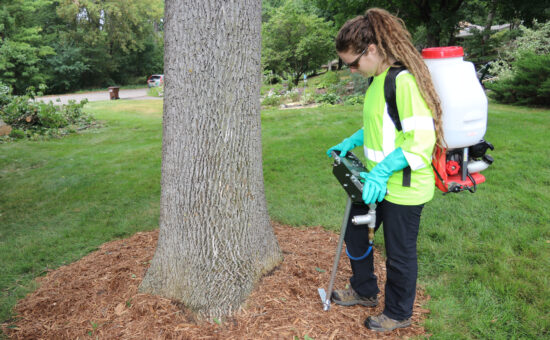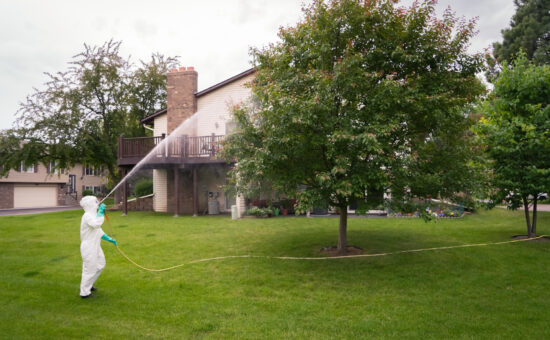Frequently Asked Questions About Treatments
Tree Trunk Injections
We have created a series of instructional videos addressing ash tree protection. Below is a short video that provides a thorough overview of an ash receiving a tree trunk injection to protect it against EAB.
On average, treatment takes approximately 10-20 minutes. Treatment time varies according to the size of the tree, the amount of product being injected, and other factors including weather conditions and the condition of the tree’s root zone. Technicians determine the amount of product used and the number of injection holes based on the severity of the pest infestation, and the size of the tree, which they determine by measuring its diameter.
Once the technician has calculated the proper dose of product, small holes are drilled into the base of the tree. The holes are drilled just deep enough to reach the vascular layer under the bark. (The vascular system is what the tree uses to move water and nutrients.) T-shaped valves are then inserted into the holes, tubing is attached to deliver product from the bottle to the valves, and the technician uses a bicycle pump to provide the pressure needed to move the liquid product. Once the product is injected, the tree’s vascular system transports it up to the tree’s canopy. Watch the short video of a tree being injected above.
Our system does not use plastic plugs or any other equipment that stays in the tree. However, if you look closely at the trunk just above the soil line, you will see small drill holes, along with “pig tails” of wood shavings removed by the drill. Most trees also receive a small tag that reads something like, “RTC 2019 EAB protected.” You will also receive communication from us telling you what product was administered and how it was used.
Injection systems insert product directly into the tree or soil, whereas sprays are applied in a mist to the outside of the plant. With injection treatments, there is no concern about waiting for the product to dry after it is applied. Also, the product never comes in contact with anything outside of the area being injected.
Because the product is inserted directly into the tree, there is no concern about overspray on the lawn or nearby landscaping plants. It is safe to use your yard right after a trunk injection has been completed. Unlike sprays, there is no need to wait for anything to dry.
With our treatment protocols, we do everything possible to avoid harming non-target species including pollinators. None of our products contain neonicotinoids. We use pollinator-safe ingredients to treat plants while they are flowering and therefore being visited by pollinators. As part of our ongoing commitment to safety and the environment, we are constantly updating our best practices to achieve desired results while also making sure treatments are safer for pollinators.
Tree trunk injections are safe to perform on trees near bodies of water including lakes, ponds, and streams. Because product is injected directly into the tree’s trunk, there is no danger of it running off and reaching nearby soil or water.
How Rainbow treats for Emerald Ash Borer
Soil Injections for Trees
Soil injections for trees are performed by using a t-shaped applicator to inject liquid product into the soil around the tree’s root zone. The tree’s roots then take up the product and transport it throughout the tree the same way water and nutrients are moved within it (through the vascular system beneath the bark).
There will be no visible marks on the tree itself. You may notice small holes where the applicator was poked into the ground. You will also receive communication from us telling you what product was administered and how it was used.
Your arborist will only recommend using soil injections if the conditions are right. If there is a danger that nearby plants would be affected, soil injections would not be recommended unless the homeowner is made aware of the risk and determines the treatment is worth it.
Our technicians will not perform soil injections if standing water is present, or if conditions present a risk of product runoff. We monitor weather conditions and perform services accordingly. Technicians will also assess the site prior to treatment to determine if it can be performed safely, or if it needs to be rescheduled.
With our treatment protocols, we do everything possible to avoid harming non-target species including pollinators. We use pollinator-safe ingredients to treat plants while they are flowering and therefore being visited by pollinators. As part of our ongoing commitment to safety and the environment, we are constantly updating our best practices to achieve desired results while also making sure treatments are safer for pollinators.
Because product is injected into the soil approximately 6”- 8” below the surface, it is safe to walk on after it has been treated. It is best to avoid digging in treated soil right after treatment. If you have dogs or kids who like to dig, we recommend keeping them away from treated soil for a few hours. If they do get into it, simply wash their paws or feet or hands using soap and water.

Soil injection being performed on a tree
Tree Sprays
The technician will walk around the tree, always spraying towards the center of the tree. Anything (such as a car or patio furniture) that can be moved from the immediate area should be moved ahead of time. Anything that can’t be moved, but can be covered, will be covered with a tarp (however, some dripping may occur once the tarp is removed). For trees overhanging buildings or decks, it is likely that some residue will be left on those objects. The residue is not harmful and will break down within 6-8 weeks. Cleaning with soap and water can speed the process.
People and pets may enter a treated area after spray has dried. An effective amount of product begins adhering to the tree and working within 15 minutes of it being applied. Drying also begins within 15 minutes of product being applied. Full drying time depends on temperature and humidity, but usually 1-3 hours is adequate time. If you are concerned that a child or pet has walked through a treated area, simply wash their feet, shoes, or paws in soap and water.
Some plants, especially certain annuals, may be sensitive to some of the ingredients we use. Most plants will tolerate any chemical we use. Check with your Consulting Arborist to see if any of your plants need to be moved or covered.
With our treatment protocols, we do everything possible to eliminate or reduce harm to non-target species including pollinators. None of our products contain neonicotinoids and we use pollinator-safe ingredients to treat plants while they are flowering and therefore being visited by pollinators. As part of our ongoing commitment to safety and the environment, we are constantly updating our best practices to achieve desired results while also making sure treatments are safer for pollinators.
We use a spreader-sticker additive in all of our spray applications, which gives it a sticky quality similar to pine sap. Within 15 minutes of it being applied, an effective amount of the product adheres to the plant and begins to dry. As the liquid dries, the spreader-sticker ensures the chemical stays put on the surface it was applied to. There is no need to reapply the spray as long as it had a chance to dry. Like pine sap, it won’t rinse off in water alone; soap and water are required to remove it. We also monitor the weather conditions, so if it rains shortly after our application, we will come back for a re-application.
It doesn’t take long to do the application. Mixing the chemical in the tank is often done before they arrive at your home. Our hoses spray at a high pressure, so circling the tree once is enough to hit the surface of all the leaves. Sometimes it takes more time to walk to the tree than it does to spray the tree! When in doubt, call your Consulting Arborist who can check your tree for residue to ensure your tree was properly covered.

A spray application being performed on a tree
Horticultural Oils (“Hort Oils”)
Horticultural oils are applied using a spray treatment.
Horticultural oils are considered non-toxic pesticides. They work by covering the insects and preventing them from taking in air. The oils also cover eggs and larvae, preventing them from maturing.
With our treatment protocols, we do everything possible to eliminate or reduce harm to non-target species including pollinators. None of our products contain neonicotinoids and we use pollinator-safe ingredients to treat plants while they are flowering and therefore being visited by pollinators. As part of our ongoing commitment to safety and the environment, we are constantly updating our best practices to achieve desired results while also making sure treatments are safer for pollinators.
One of the advantages of natural “hort oils” is that they leave no toxic residue behind, making them ideal for edible crops like fruit trees. Unfortunately, this also means they require favorable conditions to reach maximum effectiveness and to avoid damaging the plant if they cannot evaporate at the correct rate. Our technicians carefully monitor weather conditions and will reschedule a service if it cannot be correctly performed due to adverse weather.
There is no equipment left behind after a spray treatment using horticultural oils has been completed. You will receive communication from us telling you what product was administered and how it was used.



